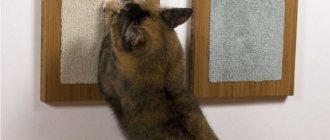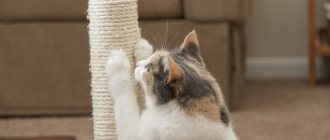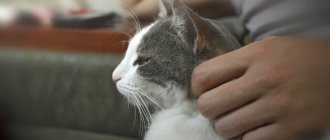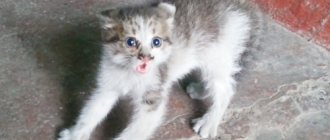Why do cats sharpen their claws?
Sharpening your claws is a natural instinct. For feral cats, keeping nails sharp and at an acceptable length is vital. Pets with proper care could theoretically not monitor the condition of their claws, but they do this because of their preserved instincts. Sharpening helps not only to reduce the length, but also to learn how to extend and retract your nails in time. Pets need this to climb play structures and other heights. Some cats have poor muscle control, which causes them to damage furniture when walking and accidentally scratch their owners.
Ingrown claws into paw pads cause pain, suppuration, changes in gait and deformation of joints
Another reason for sharpening nails is stress and lack of physical activity. In the process, animals manage to throw out excess energy and emotions. In such cases, the pet behaves anxiously, may run around the house, jump on walls, etc. After sharpening its claws, the animal calms down or goes to rest. Stress does not arise on its own, so it is necessary to calculate the root cause: hunting birds outside the window, the arrival of a new family member or pet in the neighborhood, moving and any other changes.
The house is a personal territory for the cat and helps reduce stress, therefore helping to partially solve the problem of property damage
During the process of sharpening their claws, animals leave scent marks. This happens thanks to glands on the paws that secrete an odorous secretion. The need to mark territory most often occurs in older pets. Males are more likely to sharpen their claws for this reason, although this behavior can also occur in cats. Acts of vandalism become more frequent if a new animal appears in the house or neighbors. In such cases, old-timers actively fight for their territory and not only destroy furniture, but also leave feces and urine. A similar thing happened with my sister: she got a second cat, and the first, despite having a scratching post and good manners, switched to wallpaper, sofas and carpets. Neutering both pets helped solve the problem.
Why does a cat need its place in the house?
Cats are freedom-loving and unpredictable animals. Sometimes they like to lie in the arms of their owner or look around the room, climbing to the highest point in the room. Sometimes it’s not easy to find them: they crawl into a closet, a new box and sleep quietly. To ensure that the animal does not look for a place where it can retire, its own house or soft bed is designed. Here the pet can relax and sleep sweetly. If he is unwell, the owner will easily notice this, because the animal will not hide in the corners, but will come to his “closet”.
How to prevent furniture damage
To prevent property damage, owners often use anti-scratch guards - special claw covers. Reviews about them are very different. Some argue that high-quality devices most often do not cause a negative reaction. Others have encountered problems. My friend’s cat bit off the caps and bit off several claws along with them, and bleeding began. Of course, we managed to cope without a veterinarian, but we had to forget about anti-scratch treatments. In more patient animals, their gait may change due to discomfort. This entails the development of pathologies of the musculoskeletal system. Partially the reaction depends on the quality of the anti-scratch pads and their correct trimming, but sometimes even the original pads cause rejection in the cat, so it’s better to do without a “manicure.”
Manufacturers produce anti-scratch products in different colors, but for cats there is no fundamental difference
Another reliable, but no less dangerous method is declawing surgery. During the process, the specialist cuts out the entire phalanx along with the growth zone, which prevents tissue restoration. This operation is inhumane, since the animal subsequently suffers due to pain in the scar area. If normally the tissues are protected by hard claws, then after removal of the phalanges the delicate shell can be damaged by wood filler granules, sand, rough carpet surfaces, etc. Often cats refuse trays after surgery, which leads to new problems. If the animal also experiences stress, it may begin to chew household items and furniture. It is strongly recommended to refrain from this method.
Trimming nails helps reduce the length and eliminates one of the causes of damage to property in the house. The cat does not have to sharpen its nails to prevent ingrown nails. However, the need to protect the territory, hunting instincts, stress and the need for training remain, so the measure helps only in a quarter of cases. Even with shortened claws, the animal can leave marks on wallpaper and furniture. Trimming should not be forgotten, since it helps to avoid health problems, but this measure is not enough.
For trimming, it is necessary to use special nail clippers that prevent the plate from delaminating.
A humane option is training to use a scratching post. This is a kind of compromise: the cat retains the ability to realize its instincts, and the owner does not have to regularly repair and change furniture. However, animals do not always readily agree with the new rules, so it is important to be persistent, clearly explain to your pet what is required of him, and choose a scratching post that your pet will like.
What is better - a house or a bed?
A house and a bed are an alternative to an armchair or a family bed, on which mustachioed pets really like to rest. What is better for a cat? To answer this question, it is worth getting acquainted with the design features:
- Bed. A soft, round or oval-shaped pillow made of hypoallergenic and tactile-pleasant materials. The internal filler is padding polyester or its modern analogues. It is much more comfortable for your pet to rest on a bed at night than on a hard windowsill or floor.
- House. Unlike an open-type bed, the house has a dome made of the same materials as the pillow. The lower and upper parts are connected by a side, forming a mink. A hole is provided so that the animal can get to itself. In the house the cat feels like in a box. She is warm, comfortable and safe.
When choosing a recreation area for a pet, the owner should focus on the character of the animal and the free space in the interior. If the cat is sociable, curious and loves to be the center of attention, the best choice is an open bed. A personal corner will allow the mustachioed friend to relax and communicate freely with the owner.
Types of scratching posts
First of all, scratching posts are divided into industrial and homemade. The latter are in no way inferior to the former, especially if the owner knows how to use tools, but even with no experience, a simple design can be made. For example, a wall-mounted flat scratching post. Some cats prefer regular thick cardboard, but devices made of plywood and a wooden base covered with carpet, sisal or jute will look more aesthetically pleasing. It is advisable to experiment with the material to choose the coating that your pet will like best. Craftsmen can try to make a column or an entire play complex from PVC pipes, chipboard sheets and jute or sisal.
Corner scratching posts
Corner scratching posts can be several combined plates, a structure on a stand, a shelf with a wall covering, etc. In most cases, these are compact devices that will fit even in a small apartment. Cats especially like corner scratching posts with shelves: they climb on them and watch their surroundings from above. However, it is inconvenient for tall pets to stretch out to their full height, and some pets may climb the wall or scratch it while already on a hill.
Corner scratching posts can be attached to external or internal corners
High scratching posts
Tall scratching posts can be produced in the form of standard elongated posts or with a house on top. Such devices are suitable for large animals. Cats love to sharpen their claws while stretching out to their full height, and restrictions can cause them to move onto walls and furniture. Additionally, the design with a house on top relieves the animal of stress: the pet receives a shelter in which no one will disturb it, and the opportunity to observe what is happening from above. It is important to monitor the sharpness of your pet’s claws so that he does not get injured during the descent or ascent. These scratching posts may not be suitable for kittens and miniature cats.
High scratching posts are recommended for Maine Coon owners.
Wall scratching posts
Wall-mounted scratching posts are vertical plates. They can be mounted on any flat surface and even used as a horizontal structure if your pet likes it that way. Some owners place vertical plates on the sides of furniture to prevent vandalism. It should be borne in mind that after receiving permission, the cat will also tear other chairs and sofas without seeing the difference. Wall-mounted scratching posts are well suited for those pets who often damage their wallpaper.
Wall-mounted scratching posts can be connected to shelves
Columns
The claw post is a classic option. It differs from tall devices only in size and simplicity of design. Most animals like these scratching posts, but to maintain interest, it is advisable to purchase non-standard models with toys, balls and other additions.
It is easier to accustom a cat to posts with toys and feathers
Claw beds
Scratching beds will appeal to lazy animals and those pets who like horizontal structures and carpets. Additionally, it is advisable to use such devices during training, since cats love to sharpen their claws immediately after sleep. Scratching post beds are compact: they can replace 2 pieces of furniture at once.
The main disadvantage of scratching beds is the increased accumulation of hair on the surface due to the rough, rough material
Floor scratching posts
Floor scratching posts are most often compact models with sisal or jute plates located at a slight angle. The key advantage of such models is the possibility of transportation and non-standard bending of the working surface. If the cat is not interested in other scratching posts, you should consider giving her a floor scratching post: it is possible that she will like not the vertical and horizontal plates, but the covering located at an angle.
Some designs consist of several scratching posts at once and can replace a small play complex
Game complexes
The play complex consists of several shelves that are fastened together with posts filled with jute or sisal. The design can be supplemented with stairs, houses, hammocks, feathers, balls, etc. Play complexes serve as a shelter, a toy, and a scratching post at the same time. They help keep the animal interested, avoid climbing walls and reduce stress.
Game complexes take up a lot of space, so this option is not suitable if you have limited space.
Claw houses
A claw house is another option for a compact design that can replace several pieces of furniture. The advantage of this device is that after sleep the cat is more willing to sharpen its claws. The design differs from a bed in the presence of a roof, which makes the animal feel safer, and in the vertical position of the column.
Scratching post houses are compact, but are not suitable for large animals due to the limitation of shelves
The functionality of the cat house, where is it better to install
Nowadays in pet stores you can find a varied assortment of houses for furry pets. There are several options:
- simple , which is intended for relaxation;
- vertical , which is usually equipped with a scratching post and will hold several tiers;
- floor-mounted , this option has several types of designs and sizes.
The simplest options are for sleeping. But, if the cat likes to sharpen its claws on furniture, you should purchase a more complex type with a scratching post, but a “multi-story” house is provided for games. Of course, every caring owner wants the best for his cat and buys a place for his pet to relax and play.
But quite often, owners, having brought such a useful thing, are faced with the fact that the cat categorically refuses to sleep in the house and neither time nor persuasion helps.
First of all, you should not despair; you should understand for what reasons the cat protests against the new home.
- Perhaps the house is simply cramped and not suitable in size;
- If the structure is not stable and shaky, the cat, having tried it once, may get scared and not want to return there again.
In the first case, it is necessary to change the product. But in the second, the structure should be strengthened and preferably installed in another place.
How to train a house to play and sleep in it
Often, owners do not have questions about how to accustom a kitten to a house, because they are curious, playful and love cozy places.
But it is more difficult to accustom an adult cat to a house; she has a different opinion on this matter. They themselves know where it is better for them to sleep, they already have a favorite chair for sleeping and they can always sharpen their claws there.
But difficult does not mean impossible, especially if you follow simple rules:
- Whatever type of structure is purchased, the main rule is stability. It should not frighten the animal.
- You need to arouse interest in the house. After all, every cat has a favorite toy or bedding, and perhaps he likes to play with a candy wrapper. In any case, only the owner knows how to properly interest him, and when there is interest, he will approach him with curiosity.
- Choosing a location. Every cat has a favorite place in the apartment, and there are also unloved ones, so it’s important to place the house in a place where it will feel comfortable. Even if this is a place on the closet, first you need to install the house there. When she understands that it is comfortable and pleasant there, it can be rearranged.
- When the purchase is brought home, it should be placed in a visible place and the cat should be allowed to get used to the new product. Getting used to it doesn’t mean within half an hour, it could be several days. After which you can move it and install it in different parts of the apartment. During such a move, it is recommended to put toys inside the house; if the cat shows interest and comes inside, be sure to praise it and give it some treats. At first, give the cat as much time as possible, play with her, but let the house also participate in the fun. For example, playing with a favorite toy that always ends up in the middle of the house.
- As soon as the cat comes into the house to sleep, this will mean success. She will develop a habit and will not look for a better place.
Important!
- You cannot force a cat into a house. Firstly, this will absolutely not give any results, but on the contrary, it will push her away. And secondly, it will be stressful for her, she will not understand what they want and demand from her.
- If the cat, even after following all the rules, refuses the house and nothing helps, there is another option. Pet stores have a special spray that will make your cat love its new place. Some people use sprays that contain catnip, and some use valerian as a bait.
How to train your pet to use a scratching post
First of all, you need to decide on the location of the scratching post. You should pay attention to the animal’s preferences: if a cat likes to tear up carpets after waking up, it is advisable to place a horizontal structure near the bed; in case of damage to the wallpaper, you need to secure the plates using dowels and self-tapping screws. You can leave scratching posts next to furniture that your pet scratches. It is advisable to first use several designs, and later experimentally select your favorite one and leave it alone.
In some cases, special sprays help to attract the attention of a cat, but less radical methods are suitable for kittens.
To help your cat understand what to do with the plates, you can set a personal example for her: scratch your fingers over the surface. Many animals repeat after their owners. If the pet does not understand anything, you should carefully take it by the front paws, place them on the scratching post and slightly release the claws. You can imitate the movements when sharpening. As a last resort, you can hope for an accident: place a scratching post near the beds and houses and wait for the pet to become interested. Toys, feathers and balls help to attract the animal's attention. When a cat begins to play, it involuntarily clings to the surface with its claws.
The pet should be actively praised for showing interest, petted and given treats. This is repeated every time the cat approaches or uses the scratching post. Soon the reflex becomes established, and the animal begins to associate pleasant emotions with the device. Formed habits reduce the risk of furniture damage.
The presence of a shelf in some cases speeds up the learning process: the cat has to climb and she quickly understands that jute and sisal are tactilely pleasant materials that are easy to cling to
It is important to choose an individual approach for each cat. Kittens understand more quickly what is required of them if they are stimulated with toys or have their paws placed on a scratching post. For adult animals that do not like tactile contact, it is better to lead by example or lure them to the posts using fishing rods.
Basic requirements for a cat's home
In order to tame a cat to a place without any problems, it must meet certain requirements.
Size
Any size bed will suit a kitten, but it is worth considering that as it gets older, it may be necessary to buy a new home. The cat should be comfortable in its place, and for this it should not be cramped. The ideal size of the house is slightly larger than the animal itself.
Material
It is recommended to choose soft houses with a stable bottom. This is important because cats don't trust unstable floors. You can use an ordinary cardboard box as a home, but it must be upholstered with fabric and a soft blanket or lounger placed on the bottom.
Important! The shape and type of the house is chosen individually.
The modern market offers a wide choice. This could be a regular booth house, a built-in house, a hammock, or a full-fledged play complex. It all depends on the personal preferences of the owners.
I recommend: Stroller for cats: fashion or necessity? (6 photos 2 videos)
What to do if your cat doesn't want to use a scratching post
An adult cat can be punished for damaging furniture, but not for lack of interest in the scratching post. It is possible to eliminate motivation with the help of strong odors or an unpleasant coating: tape spread over the surface, wax strips, foil, applicators with spikes, etc. Animals are repelled by the aroma of citrus fruits, vinegar and essential oils.
Not all cats react the same way to standard stimuli, so in each case you will have to look for an individual approach
You should not hit the cat, as this will only increase stress. As a last resort, you can use a spray bottle or a noise trap made from an empty can and nuts or coins to prevent property damage. The method should not be used on kittens or weakened pets. Sooner or later, in the absence of alternatives, the pet will become interested in the scratching post. You need to wait for this moment and start praising the animal vigorously.
Optimal house arrangement
In order for a pet to recognize a new home, it must meet special cat standards:
- Dimensions . A cat needs comfort and protection, so you need to carefully select housing according to the size of your pet. If the house is cramped or too large, the animal will refuse to spend the night in it.
- Quality of material . There is no need to save; preference is given to frames made from natural components - wood. Make sure that the upholstery fabric is soft, pleasant to the touch, and does not electrify, otherwise your pet will refuse to live in the house. Plush and carpet are the most acceptable; other natural fabrics can also be used. Synthetic padding and foam rubber are used as padding for the bed. A good option would be a homemade mattress made from familiar materials. Use an old shirt or robe that your pet likes to lie on. If he has a familiar bedding, move it into the house, making it easier to get used to.
- Smell . Before purchasing, sniff the house. There should be no strong odors; do not forget that a pet’s sense of smell is sharper than a human’s. If the housing emanates aromas of glue and low-quality materials, the fluffy will refuse to enter it.
- Sustainability . Cats are frightened by shaky structures, so check the security of the housing and secure it carefully. If an animal gets scared once in the house, it will ignore it in the future.
- Installation location . Place your pet's home in a secluded corner, not in the aisle. Cats love it when there is a radiator nearby - this provides comfort in winter, but you should not place the structure too close to the heating device - overheating causes molting.
- Emergency exits . The instinct of a predator makes fluffies care about their safety, so a house with several holes will be to their liking.
- Ventilation . Cats love ventilated rooms, so that unpleasant odors do not accumulate, and a comfortable temperature in summer and winter.
- Functionality . Pets are attracted not only by cozy, but also interesting designs - cats are very curious. It could be a multi-story structure with labyrinths. The pussy will be interested in an open complex with a scratching post. Metal parts will not only attract attention, but also ensure the stability and safety of the structure.
- Gender characteristics . Consider the gender of the cat when choosing a design. Males, by nature, must control the surrounding space, so houses on stands, with several tiers in height, are suitable for them. Females care for their young and tend to live in cozy, enclosed spaces.
Recommendations from experts
First, you need to wean your cat from sharpening furniture. There are special sprays for this.
And you should try to accustom him to the scratching post with the help of games.
Make a bow on a string, and when the cat is chasing it, put it on the scratching post - the cat should like it.
Evgenia Aleksandrova
https://forum.koschki.ru/index.php/topic/34-kak-priuchit-vzrosluiu-koshku-k-kogtetochke/
Encourage every time you see the scratching post being used: if you sharpen it, you get a treat, you praise it, you pet it. I tried to approach the sofa - they shushed me, slammed me with a newspaper, and sprayed me with a spray bottle. During the day, you can cover the armrests of the sofas with something like large towels/bedspreads so that it is inconvenient for him to touch them. In the meantime, someone is at home, watch, listen. Gradually, a reflex will form that the sofa is a nuisance, and the scratching post is a pleasure. Well, look for yourself: if the apartment is large, then it makes sense to install several scratching posts so that it is always at hand (under the paw, in the sense). Catnip and other baits will also play a role, but your behavior will matter more.
Mrss
https://www.u-mama.ru/forum/family/pets/714922/
Many cats do not like small scratching posts - it should be 65 - 70 centimeters high - otherwise the cat will not be able to stand on its hind legs and stretch out. When caught in the act of a crime, you take him to the scratching post and scratch it with his paws. Treat the scratching post with catnip and show it to the cat; many people react well to mint. Many people love corner scratching posts. When you leave, you can put a cover made of polyethylene film on the sofa. Or, leaving the cat alone, close the room - his bed is in the corridor, let him go to the kitchen to eat, to the toilet, and that’s it.
OAya
https://www.u-mama.ru/forum/family/pets/714922/
Features of training pedigree cats
Purebred cats are taken from friends, pet stores, nurseries and shelters. They teach rules of behavior consistently and patiently.
Hemorrhoids in cats, cats and kittens: how to treat
First, the cat is given a nickname, short and sonorous. They repeat it often and kindly. When he responds and approaches, he is rewarded with a treat. They constantly talk to the ward. Cats understand not words, but intonation. They react sensitively to the mood of the owner and understand the mood by tone.
At the same time, they are taught to behave correctly. One command is a ban, then, when the cat understands and begins to comply, another useful habit. The kitten is given an understanding of what it should not do: bite its owner, scratch furniture. Forbidden "Ugh!" and “You can’t!”, accompanied by the clapping of palms, the pupils understand quickly.
Important! The animal is rewarded for following commands, and punished for misdeeds. But immediately, and not in a few hours, the cat will not understand and will harbor a grudge
Beatings are unacceptable.
Pets are taught not to climb on the table. They are taught to eat in one place and from the same utensils, to go to the toilet using a tray or toilet. Poking a kitten's nose into its puddle is inhumane and pointless. It is better to patiently lead him to the right place, stay with him, and encourage him after the right actions.
Toys for pets are important in the process of getting used to a new place
How to choose a cat house
When choosing a house, pay attention to its convenience and comfort. It's great if he's beautiful, but that's not the main thing. The main task is to meet the cat’s requirements, because she will have to live in it. Here are some points that you should pay special attention to.
- House size. It should match the size of your cat. If you are choosing housing for a kitten, choose one for growing up. Based on the breed of the animal, you can roughly determine what size it will reach in adulthood (cats of some breeds grow quite large). The house should not be too cramped and not too large. The cat should feel comfortable and safe in it. Make sure that your home needs space for soft bedding and your favorite cat toys.
- Location of the house. There are housing for cats located at a certain height from the floor. This is the best option. Cats are predators; they prefer habitats “at heights” for a good overview of the area.
House located on a hill
- The material from which the house is made. Avoid electrified synthetic materials whenever possible. Of course, it will be difficult to choose a house for a cat made of natural wool, so rely on “touch.” The fabric (fur) should be pleasant and resemble a cat's skin. This is especially important for a kitten - it associates the material of the house with the side of the mother cat. Having found his home cozy, he will more easily survive weaning from his mother’s breast.
- Construction device. If the cat is an outdoor cat, a house on an elevated surface with simulated tree trunks (posts wrapped in rope) and steps is suitable for it. The domestic cat will also be interested in the complex design.
- Sustainability. A shaky house will not interest any cat; it will not give it the necessary feeling of security and comfort.
- Availability of emergency exit. The cat will be much more comfortable if the house has two exits.
Cat house with two exits
The next step after choosing a cat house is its proper location. Let's consider some features on which an animal's favor towards a new place of residence depends.
How to choose a place for a house
Each breed has its own preferences. The issue will be discussed in more detail in Table 1. But there are general requirements for the location of a new home; they must be taken into account first of all:
- absence of drafts;
- location near heating devices;
- location of the home near a computer, TV and other objects that emit radiation.
Table 1. Cat breed and preferred location of the cat house.
Scottish and British
At the first stage of training, do not place the house in the place of the cat’s former bedding, to which she is accustomed. Instead of acceptance, it can cause rejection. Place the dwelling close to the litter and begin to actively accustom the animal to it.
Attention! Being located near heating devices activates shedding and simply hair loss. It is strictly forbidden to place a house near a radiator for cats of long-haired breeds.
How to protect your cat from hairballs in her stomach when shedding?
Method two: favorite place
The conservatism of many furry pets is manifested in the fact that they prefer the same place in the apartment to sleep. In this case, we take the house and put it there. Cats are stubborn, they will sleep where they are used to, regardless of what is standing or lying there. It is very likely that the cat will start sleeping in the house, which in a couple of weeks can be moved to a new location. You shouldn’t do this before, or the purr will return to where it slept before.
Common types
In addition, teaching a cat to scratch a scratching post will be easier if you choose the right type of scratching post. When making this choice, you should take into account the habits and temperament of your pet.
So, what types of scratching posts are there? There are 7 types of them :
- Column. It will benefit not only the pet’s claws, but also its skeleton and muscles, since the mustachioed one will be able to climb on it and frolic very happily.
- House. In addition to the fact that the cat will be able to sharpen its claws, it will also acquire a secluded place for itself. An excellent option would be to choose a house with parameters of 30x30 cm. You can train a cat to a house with a scratching post in the same ways as to a regular one.
- Playground. It is a combination of a labyrinth and a variety of stairs, which will be excellent entertainment for the animal.
- Cardboard scratching post. Its disadvantage is its fragility, since it wears out quickly. A plus is that this scratching post is made of environmentally friendly material.
- Jugite is an excellent material for sharpening claws.
- Sisal is more stable in use than the above options.
- Wooden is the most durable of all types.
© shutterstock
What actions should you avoid?
In addition to the rules, there are also prohibitions in the process of house training cats. You cannot do the following:
- Use force. By pushing your pet into the house, you stimulate not action, but reaction. A cat can completely and irrevocably fall out of love with the home prepared for it;
- Breaking the animal's old habits. Think about how to create conditions inside the house to which the cat is accustomed.
If you've tried everything and nothing works, try using catnip spray. This secret weapon often works. Your pussy will not be able to resist its magical aroma.











